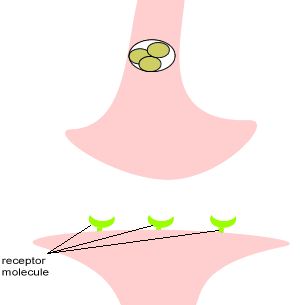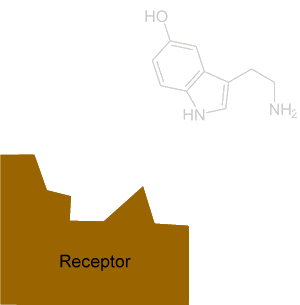Neurotransmitters
Chemicals that make us who we are
Our brain relies on constant communication between nerve cells in order to learn new tasks or just coordinate simple movement. Unlike the electrical circuits that we are familiar with, which have wires that are in constant contact with each other, nerves are separated by a space called a synapse. Communication between nerve cells is done via chemicals called neurotransmitters. These neurotransmitters are packaged in tiny, compartments, known as vesicle and travel to the end of the nerve when a signal needs to be transmitted to a neighbouring nerve. The image on the right shows vesicles carrying the neurotransmitter to the synapse.
When the neurotransmitter is released into the synapse it migrates over to special proteins, known as receptor molecules, on the surface of the neighbouring nerve. When the neurotransmitter and receptor bind a chemical sequence of events is unleashed that causes the neighbouring nerve to become excited and carry the signal.
The receptor and the neurotransmitter must fit each other perfectly, much like a lock and key.
At first, this mechanism of dumping neurotransmitter into the synapse might appear quite inefficient, but this mechanism allows for the body to regulate the intensity of the signal that travels from nerve to nerve and even to stop it. In this way pain signals can be moderated or even stopped completely from travelling to the brain and other signals amplified to prevent conditions such as depression.

Serotonin, shown on the right, is one of many neurotransmitters found in the brain and is responsible for influencing brain cells responsible for regulating mood, sexual desire and function, social behaviour, appetite, memory and sleep.
An imbalance of these chemicals, known as neurotransmitters, in our brain causes depression, anxiety and personality disorders just to name a few.
Hallucinogenic drugs, such as LCD, often mimic the action of certain neurotransmitters in the brain. They have similar shapes to specific neurotransmitters and so fit onto the recpetors causing over excitation of the nerve or at other times totally preventing the signal from been transmitted.
The animation on the right shows how similarities in the shape of serotonin and LSD allows LSD to excite the serotonin receptors in the brain.

Dopamine is a neurotransmitter that helps control the brain's reward and pleasure centers as well as being involved in regulating movement and emotional responses. In doing so it enables us to see rewards, and to physically move toward them.
Dopamine is also linked to risk taking behaviour.
Metamphetamines hijack the dopamine system and cause the release of an extreme amount of dopamine thus overwhelming the reward and pleasure system and leading to extreme risk taking behaviour.
